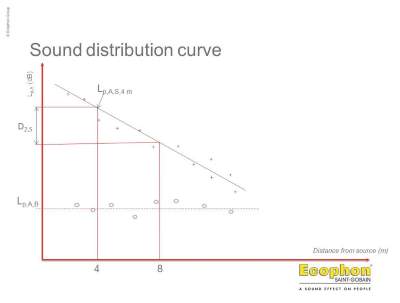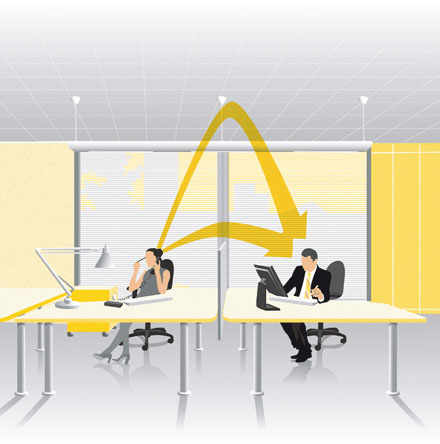Sound propagation
The sound level decreases as the distance from the sound source increases. The design of the room (shape, furnishing, surface finish etc.) influences the extent to which the sound level decreases along with the distance.
Speech at 1 m distance
Speech at 4 m distance
Speech at 8 m distance

To characterise the propagation of the sound there is a parameter that describes the extent to which the sound decreases when the distance is doubled. This parameter, is the rate of spatial decay of A-weighted sound pressure level of speech per distance doubling and is designated D2,S. It is measured in dB and determines the slope of the sound propagation curve.
Another parameter is the A-weighted sound pressure level of speech at 4 metres Lp,A,S,4m, also measured in dB, which shows how high the speech level is at 4 metre distance from the sound source.
The target values for good acoustic conditions in an open plan office are, according to the ISO3382-3, D2,S ≥ 7 dB, Lp,A,S,4 m ≤ 48 dB,
 Distance of comfort rc
Distance of comfort rc
Besides the parameters given in ISO 3382-3, the distance of comfort (rc) can be calculated. The comfort distance corresponds to the distance at which the sound pressure level falls to a pre-defined acceptable comfort level (Lc).
It is recommended to look at when the level has decreased by 10 dB from a typical speech level in an open-plan office at 1 metre distance from speaker. Knowing the parameters D2,S and Lp,A,S,4 m the comfort distance is given by:
rc = 4x10 0.3(Lp,A,S,4m - Lc) /D2,S
If the speech comfort level Lc is chosen to be 48 dB(A), i.e. 10 dB below a typical speech level in an open-plan office which is 58 dB(A) at 1 metre, then the Distance of comfort is equal to 4 meters. A 10 dB decrease in sound pressure level corresponds approximately to a halving of the subjectively perceived sound strength.
Articulation Class (AC) is a classification of suspended ceilings according to their ability to contribute to the acoustic privacy between work stations. This method provides measurements of the sound reflective characteristics of ceilings used together with screens. The higher the AC value of a ceiling, the more efficient it will be to reduce sound propagation.
|
Perceived attribute |
Objective descriptor |
Designation |
Unit |
Explanation |
Standard |
|
Spatial decay |
Rate of spatial decay of sound pressure per distance doubling. Spatial decay rate of A-weighted SPL of speech, D2,S |
D2,S |
dB |
Measures how much the sound of speech decreases with distance from sound source. |
ISO 14257 33823 |
|
Spatial decay Sound pressure level of speech at 4m distance |
A-weighted SPL of speech at 4 meters, Lp,A,S,4m |
Lp,A,S,4m |
dB |
Measure of room’s contribution to the sound of speech at 4 meters distance from sound source. |
ISO 14257 33823 |
|
Spatial decay |
Articulation Class |
AC |
Index |
Classification of ceilings in accordance with their ability to contribute to privacy in open-plan offices. |
ASTM E 1110 (2001) |
